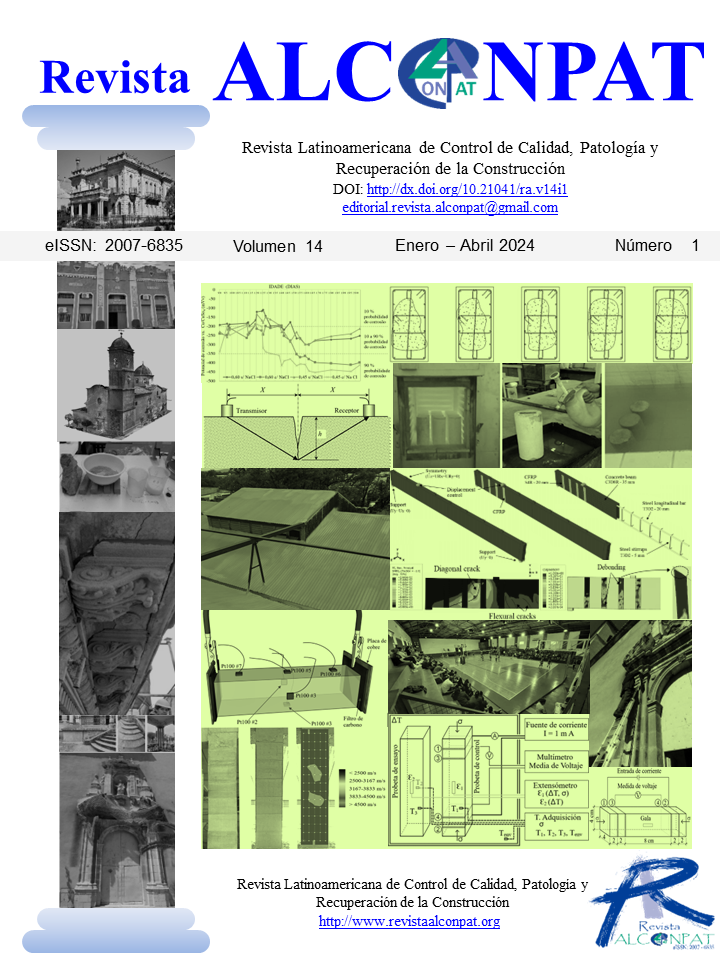Pathological study using ultrasound tests applied to structures under construction
DOI:
https://doi.org/10.21041/ra.v14i1.715Keywords:
non-destructive testing, ultrasonic pulse velocity, anomalies, rehabilitation, concreteAbstract
The study discuss the results of the evaluation of reinforced concrete structures using non-destructive testing (NDT) based on ultrasonic pulse velocity (UPV) with the objective of determining the integrity and uniformity of the concrete, as well as detecting possible anomalies caused during construction or by external factors. The results showed the distribution of damage in a structure affected by fire, the measurement of cracking depth in a concrete element and the uniformity in different structural components, which subsequently allowed the development of the corresponding structural rehabilitation procedure. The study demonstrates the effectiveness of NDT and VPU in the evaluation of reinforced concrete structures, allowing immediate repair and rehabilitation decisions to be made.
Downloads
References
American Society for Testing and Materials (2002), ASTM C 597-02, Standard Test Method for Pulse Velocity Through Concrete.
American Concrete Institute (2013), Report on Nondestructive test Methods for Evaluation of Concrete in Structures, ACI 228, 2R-13. American Concrete Institute, EUA.
American Concrete Institute (2001), Control of Cracking of Concrete Structures, ACI 224R-01. American Concrete Institute, EUA.
American Concrete Institute (2014), Guide to Concrete Repair – Report by ACI Committee 546, ACI 546R-143. American Concrete Institute, EUA.
American Concrete Institute (2009), Surface Repair Using Form-and-Pour Techniques – Field Guide to Concrete Repair Application Procedures, ACI RAP Bulletin 4. American Concrete Institute, EUA.
Feldman R.F. (1977), CBD 187 Non-Destructive Testing of Concrete, Canadian Building Digest, Division of Building Research, National Research Council Canada,
Malhotra V. M., Carino N. J. (2004), “Handbook on Nondestructive Testing of Concrete”, Boca Raton, Florida, USA, cap 8, pp 8-1 – 8-19
Souza, F. C., Pinto R. C. A. (2020), Ultrasonic investigation on the effectiveness of crack repair in concrete. IBRACON Structures and Materials Journal.
Published
How to Cite
Issue
Section
License
_______________________________
License in effect from September 2020
You are free to:
- Share — copy and redistribute the material in any medium or format for any purpose, even commercially.
- Adapt — remix, transform, and build upon the material for any purpose, even commercially.
- The licensor cannot revoke these freedoms as long as you follow the license terms.
Under the following terms:
- Attribution — You must give appropriate credit , provide a link to the license, and indicate if changes were made . You may do so in any reasonable manner, but not in any way that suggests the licensor endorses you or your use.
- No additional restrictions — You may not apply legal terms or technological measures that legally restrict others from doing anything the license permits.
Notices:
You do not have to comply with the license for elements of the material in the public domain or where your use is permitted by an applicable exception or limitation .
No warranties are given. The license may not give you all of the permissions necessary for your intended use. For example, other rights such as publicity, privacy, or moral rights may limit how you use the material.





















.png)














